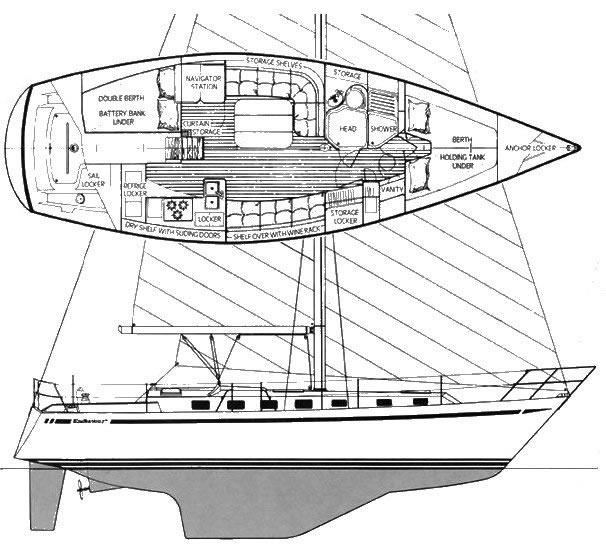|
OVERVIEW
DESIGNER: Johann Valentijn
PRODUCTION: 1984–1990
HULLS: About 215 made
(aft- and center-cockpit)
SPECIFICATIONS
LOA: 38'3"
LWL: 32'0"
BEAM: 12'8"
DRAFT:
SHOAL: 4'11"
DEEP: 5'7"
DSPL: 17,800lbs
BALLAST:
Aft: 7,000lbs
Ccpt:
8,800lbs
(internal lead)
DWL: 58' 4"
SAIL AREA:
SLOOP: 703.69 sq ft
100% FT:
SLOOP: 427.13 sq ft
MAIN:
SLOOP: 276.56 sq ft
SLOOP:
I = 51'
J = 16.75'
P = 44.25'
E = 12.50'
See Rigging Specifications for specifics
AUXILIARY:
Yanmar (diesel):
• 3-HMF (30hp)
(Aft base model)
• 3-JHE (40hp)
• 4-JHE (44hp)
(Ccpt base model)
HEADROOM: 6'4"
BERTHS: 6
FUEL:
• Aft: 30 gal (alum)
• Ccpt: 34 gal (alum)
WATER:
• Aft: 76 gal (2 tanks)
• Ccpt: 70 gal (2 tanks)
HOLDING TANK:
• 12 gal (2 tanks)
STATISTICS
D/L RATIO: 239.78
(less than 100 = ULDB
100-200 = light,
200-300 = medium,
+300 = heavy)
SA/D RATIO: 16.71
(14 = low, 22 = high)
BAL/D RATIO: 39.77%
(33-45 is average, higher=more stablitiy)
LWL/BEAM: 2.51
(2.3=low, 2.7=medium, 3.0=high)
CAPSIZE RATIO: ????
(Less than 2.0 is prefered)
MOTION COMFORT: ????
(RANGE = 5 - 60: Higher number means more comfort in a sea)
HULL SPEED: 7.6 knt
PDF DOWNLOADS
E38 B/W Brochure
E38 Color Brochure
E38 Boat Review
|
D E S I G N & & H I S T O R Y H I S T O R Y
In 1981, Endeavour commissioned Johann Valentijn to design, what would be his first production cruiser for an American client: the Endeavour 38. The Endeavour 38 was introduced for the 1984 sailing season.
 Although unverified, the E38 apparently was offered with two differrnet keel depths, which may have been an option on later model boats. Our understanding is that there is a shallow but longer keel (4’11” / 150cm) which is the original ‘documented’ design by Johan Valentijn, which was stretched aft towards the prop, and a deeper but narrower keel (5’7” / 168cm) which would provide better windward performance. Although unverified, the E38 apparently was offered with two differrnet keel depths, which may have been an option on later model boats. Our understanding is that there is a shallow but longer keel (4’11” / 150cm) which is the original ‘documented’ design by Johan Valentijn, which was stretched aft towards the prop, and a deeper but narrower keel (5’7” / 168cm) which would provide better windward performance.
H U L L & & D E C K D E C K
According to Johann Valentijn, ". . . the HULL has a medium displacement for its waterline length. The section shape forward is a soft "V" that goes into an almost flat bottom amidships for increased stability and span for the keel. Aft the sections stay flat and full with straight diagonals. The keel sections are developed from systematic testing that was done on America's Cup Contenders. . . ."
 Construction of the hull consists of GRP with a 3/4" klegecell core. The inside and outside shell have a minimum thickness of 1/4" solid fiberglass each in the bottom and slightly less in the topsides. The interior bulkheads are glassed in and form part of the total structure. The keel areas, maststep, chainplates and engine beds are made with a special steel structure to increase strength and stiffness of those highly loaded areas. Construction of the hull consists of GRP with a 3/4" klegecell core. The inside and outside shell have a minimum thickness of 1/4" solid fiberglass each in the bottom and slightly less in the topsides. The interior bulkheads are glassed in and form part of the total structure. The keel areas, maststep, chainplates and engine beds are made with a special steel structure to increase strength and stiffness of those highly loaded areas.
 It is interesting to note that a Mr. Lon Sey, Chief Engineer at Endeavour Yachts mentioned in a review that the Endeavour is a boat that is built to last at least 12 to 15 years and at Endeavour they doubted that organic materials would last that long. It is interesting to note that a Mr. Lon Sey, Chief Engineer at Endeavour Yachts mentioned in a review that the Endeavour is a boat that is built to last at least 12 to 15 years and at Endeavour they doubted that organic materials would last that long.
 The Klegecell gives the boat a light, stiff but strong hull which kept the center of gravity down low. This in turn allowed a very full interior and a stable boat that can carry a large rig quite easily. The Endeavour 38 used a large steel grid glassed into the hull. The Klegecell gives the boat a light, stiff but strong hull which kept the center of gravity down low. This in turn allowed a very full interior and a stable boat that can carry a large rig quite easily. The Endeavour 38 used a large steel grid glassed into the hull.

R U D D E R & & S T E E R I N G S T E E R I N G
The Rudder is molded as a single piece of solid high density foam with a protective skin of fiberglass and gelcoat finish. The rudder post, which is molded integrally inside the rudder, is solid stainless steel and is welded to a steel blade in the interior of the rudder. The high lift skeg-mounted rudder provides hands off tracking and ease of steering.
 A pedestal steering system is installed and operates with stainless steel cables rotating a radial quadrant bolted and keyed to the rudder post. The cables run from the radial quadrant to idler sheaves beneath the pedestal and then up into the pedestal where they are shackled to a stainless steel chain running over a sprocket on the steering wheel shaft. A pedestal steering system is installed and operates with stainless steel cables rotating a radial quadrant bolted and keyed to the rudder post. The cables run from the radial quadrant to idler sheaves beneath the pedestal and then up into the pedestal where they are shackled to a stainless steel chain running over a sprocket on the steering wheel shaft.
S P A R S & & R I G G I N G R I G G I N G
The rig is a sloop rig and the aspect ratio of both the fore triangle and the main sail is chosen to give maximum performance for a given sail area.
 All spars (mast, booms and spreaders) are extruded aluminum 6061-T6 alloy with a protective anodized coating on all external surfaces. The mast is stepped through the cabin overhead onto the steel grid's compression frame which is bonded and mechanically attached to the keel. All spars (mast, booms and spreaders) are extruded aluminum 6061-T6 alloy with a protective anodized coating on all external surfaces. The mast is stepped through the cabin overhead onto the steel grid's compression frame which is bonded and mechanically attached to the keel.
 The forestay attaches to the stemhead fitting at the bow. All other stays and shrouds are attached to chainplates at the deck. Chainplates are either stainless steel straps through bolted to heavy structural bulkheads, in the case of the upper and intermediate shrouds, or stainless tie rods, I the case of the lower shrouds. All standing rigging is attached to chainplates with adjustable turnbuckles. The forestay attaches to the stemhead fitting at the bow. All other stays and shrouds are attached to chainplates at the deck. Chainplates are either stainless steel straps through bolted to heavy structural bulkheads, in the case of the upper and intermediate shrouds, or stainless tie rods, I the case of the lower shrouds. All standing rigging is attached to chainplates with adjustable turnbuckles.
 All halyards are pre-stretched jacketed Dacron line to minimize stretch and maximize service life. All halyards are run internally in the mast. All halyards are pre-stretched jacketed Dacron line to minimize stretch and maximize service life. All halyards are run internally in the mast.
I N T E R I O R
 The interior of the Aft-Cockpit E38 is built up of wood. A framework of 3/8" plate steel is constructed and placed in the bilge and heavily bonded in place with woven roving. A plywood sole is glued and screwed on top of the steel grid and bonded to the hull. All subsole wood is saturated with polyester resin to seal all exposed grain. The sole is Teak & Holly. The interior of the Aft-Cockpit E38 is built up of wood. A framework of 3/8" plate steel is constructed and placed in the bilge and heavily bonded in place with woven roving. A plywood sole is glued and screwed on top of the steel grid and bonded to the hull. All subsole wood is saturated with polyester resin to seal all exposed grain. The sole is Teak & Holly.
 The interior is well laid out. As you descend into the main cabin, the galley is to starboard with a large settee forward. On the opposite side of the boat, a double berth is tucked under the cockpit—for privacy, a curtain can be drawn. The nav station is just forward of the berth and faces a large L-shaped settee around the dining table. The main bulkhead runs across the boat at the mast and carries some of the rigging load. Forward of this bulkhead is a large head with a separate shower stall. Opposite the head are hanging lockers and a vanity with a large comfortable V-berth in the forepeak. The interior is well laid out. As you descend into the main cabin, the galley is to starboard with a large settee forward. On the opposite side of the boat, a double berth is tucked under the cockpit—for privacy, a curtain can be drawn. The nav station is just forward of the berth and faces a large L-shaped settee around the dining table. The main bulkhead runs across the boat at the mast and carries some of the rigging load. Forward of this bulkhead is a large head with a separate shower stall. Opposite the head are hanging lockers and a vanity with a large comfortable V-berth in the forepeak.
 On the E38 Aft-Cockpit there are 15 opening ports with screens and 6 opening deck hatches. On the E38 Aft-Cockpit there are 15 opening ports with screens and 6 opening deck hatches.
A U X I L A R Y
The E38, over it's build life, came with at least 3 different Yanmar diesel auxiliaries: 3-HMF (30hp) was the base model on the aft cockpit boats with an option to upgrade to larger auxilliaries, the 3-JHE (40hp) and the 4-JHE (44hp). The 4-JHE was the base model on the heavier center-cockpit model.
E L E C T R I C A L . .S Y S T E M
All wiring is plastic coated 10 gauge stranded cooper with crimp type connectors used alt all junctions or terminals. All DC wiring is two wire, color coded: red (positive) and yellow (negative. Battery cables are: red (positive) and black (negative). All AC wiring is three wire, color coded: black (hot), white (AC common) and green (case grounded).
 Metallic fittings below the water line are electrically bonded together with green coasted 8 gauge copper wire and connected to a common ships ground. Metallic fittings below the water line are electrically bonded together with green coasted 8 gauge copper wire and connected to a common ships ground.
 The DC system is powered by two 12-volt batteries connected in parallel. The DC system is powered by two 12-volt batteries connected in parallel.
 The A.C. system operates on a 115 volt, 60-cycle alternating current. Power is supplied from a 30 ampere shore service. The A.C. system operates on a 115 volt, 60-cycle alternating current. Power is supplied from a 30 ampere shore service. |

